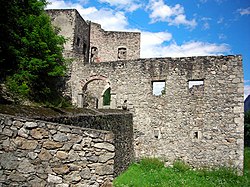Lienz hermitage
The Lienzer Klause is a hermitage in East Tyrol . The hermitage was never besieged or stormed, as the surrounding area was mostly under constant rule. However, it only found historical significance after its abandonment during the French Wars .
location
The hermitage is located on a narrow part of the Drautal valley south of Lienz ( Leisach municipality ) and forms the eastern end of the Pustertal valley . It is located on the old Poststrasse , which used to be the only road along the valley and is located at the narrowest point of the Drautal on the left bank of the Drau .
history
The Lienzer Klause was first mentioned in a document in 1241 and 1253 together with Neuchâtel Castle near Lienz. Both fortifications belonged to the then bishops of Brixen , who had them built due to armed conflicts with the Counts of Gorizia . In order to protect their properties near Anras and Assling from hostile takeover, they built the Lienzer Klause at the narrowest point of the Drautal. In the decades that followed, the Counts of Gorizia vigorously tried to incorporate the fortifications into their possession. They finally succeeded, although the timing is not known. The Fortress Neuchâtel was left to decay, but the hermitage was kept in good condition to secure the surrounding area. The Lienzer Klause was not a border fortress, but an internal fortress of the Gorizia and later also Tyrolean possessions.
From the 14th century the complex was not only a defensive structure, but also the seat of a court . The latter stayed there until 1806 before it was moved to Lienz.
Due to the continuing threat from the Ottomans , the hermitage was continuously expanded in the 15th and 16th centuries . Most of the medieval buildings were demolished. In 1661 the armistice between the Archduchy of Austria and the Ottomans was terminated. For this reason, the hermitage was expanded by the builders Christoph and Elias Gumpp according to the most modern knowledge of the time. In 1664 and 1665, the hermitage was expanded into a fortress towards the east with far reaching bastions .
Five years later the masonry was reinforced again. But farmers and citizens were also used as defenders. According to a decree from 1599, in times of need they were obliged to leave their families and their homes and stand by to rescue and protect the hermitage. In return, however, they were released from the city of Lienz's market constraints and were allowed to sell their self-produced goods anywhere in the County of Tyrol . However, when the threat from the Ottomans was averted, the Lienzer Klause slowly lost its importance.
In the 1760s a new road was built in the valley. The old high post road lost its importance and with it the hermitage. At this point the walls of the hermitage reached down to the Drau, which was equivalent to a complete dam. The walls below the hermitage were finally removed when the Pustertal Railway was built. In 1782 the fortress was finally abandoned by the state and offered for sale to private individuals.
Although the hermitage fell into disrepair over time, it was to play an important strategic role again in the French wars and the Tyrolean uprising in 1809. The Austrian military had left the Tiroler Landsturm and they were therefore on their own. The Landsturm established the Lienzer Klause as a line of defense and retreat. At the beginning of August, French troops under General Rusca invaded East Tyrol from Carinthia . The French tried to get inland. On August 8th, the battle finally broke out at the Lienzer Klause. There the Tyrolean and Sesto landstürmern succeeded in defending the severely threatened hermitage against a twenty-fold superior force of French and Italians and in stopping the advance of the attackers. General Rusca was thus denied access to the Puster Valley and he finally had to withdraw. Even today a memorial column in Burgfrieden with an inscription reminds of this battle.
In 1879, Franz Huber acquired the hermitage. He was the owner of an inn in Burgfrieden and financed the purchase by selling it. Huber initially wanted to abandon the fortress and sell its stones, but the hermitage was placed under monument protection. The first renovation work began in the 1870s. Today the Lienz Klause is in ruins . Their total decline is prevented by private and public funds. The Lienzer Klause is currently privately owned by Anton Huber, who tries hard to preserve the ruin and has meanwhile also received an award from the monument office .
literature
- Wilfried Beimrohr, Magdalena Hörmann-Weingartner: Neuchâtel / Lienzer Klause . In: Magdalena Hörmann-Weingartner (Ed.): Tiroler Burgenbuch. IX. Volume: Val Pusteria . Athesia Publishing House, Bozen 2003, ISBN 978-88-8266-163-2 , pp. 423–437.
- Wilfried Beimrohr: The Lienzer Klause , in: Osttiroler Bote from July 20, 2006, p. 38.
- Chronicle of the market town of Sillian: JOSEF ACHAMMER - Schützenhauptmann
- Bernd Lenzer: A fortress for freedom , in: Osttiroler Bote from August 30, 2007, p. 25.
- Martina Holzer: My beloved Lienzer Klause , in: Osttiroler Bote from July 17, 2008, pp. 38–39.
Web links
- Entry via Lienzer Klause on Burgen-Austria
- Brief historical overview on dickemauern.de
- History on the Leisach community website
- Entry on Lienzer Klause in the Austria Forum (in the AEIOU Austria Lexicon )
Coordinates: 46 ° 47 ′ 45 ″ N , 12 ° 43 ′ 21 ″ E
